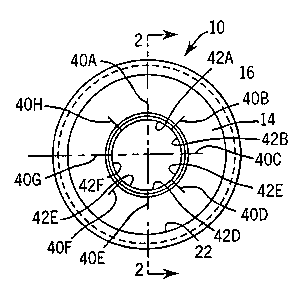Une partie des informations de ce site Web a été fournie par des sources externes. Le gouvernement du Canada n'assume aucune responsabilité concernant la précision, l'actualité ou la fiabilité des informations fournies par les sources externes. Les utilisateurs qui désirent employer cette information devraient consulter directement la source des informations. Le contenu fourni par les sources externes n'est pas assujetti aux exigences sur les langues officielles, la protection des renseignements personnels et l'accessibilité.
L'apparition de différences dans le texte et l'image des Revendications et de l'Abrégé dépend du moment auquel le document est publié. Les textes des Revendications et de l'Abrégé sont affichés :
| (12) Brevet: | (11) CA 2175642 |
|---|---|
| (54) Titre français: | BAGUE DE GRAISSAGE DE LA ROTULE D'UN DOUBLE JOINT DE CARDAN |
| (54) Titre anglais: | DOUBLE CARDAN UNIVERSAL JOINT BALL AND SOCKET SEAL |
| Statut: | Durée expirée - au-delà du délai suivant l'octroi |
| (51) Classification internationale des brevets (CIB): |
|
|---|---|
| (72) Inventeurs : |
|
| (73) Titulaires : |
|
| (71) Demandeurs : |
|
| (74) Agent: | LAVERY, DE BILLY, LLP |
| (74) Co-agent: | |
| (45) Délivré: | 2003-02-04 |
| (22) Date de dépôt: | 1996-05-02 |
| (41) Mise à la disponibilité du public: | 1997-04-26 |
| Requête d'examen: | 1998-04-07 |
| Licence disponible: | S.O. |
| Cédé au domaine public: | S.O. |
| (25) Langue des documents déposés: | Anglais |
| Traité de coopération en matière de brevets (PCT): | Non |
|---|
| (30) Données de priorité de la demande: | ||||||
|---|---|---|---|---|---|---|
|
Un joint d'étanchéité en élastomère pour un appareil de centrage de bille et de douille d'un joint universel à vitesse constante et à double cardan présente des stries rayonnantes à partir d'un trou dans lequel la bille est reçue qui créent des doigts qui se plient pour frotter contre la bille et retenir la graisse dans le joint d'étanchéité alors que le joint est tourné à travers un angle.
An elastomeric seal for a ball and socket centering apparatus of a double cardan constant velocity universal joint has slits radiating from a hole in which the ball is received which create fingers that flex to wipe against the ball and retain grease in the seal as the joint is rotated through an angle.
Note : Les revendications sont présentées dans la langue officielle dans laquelle elles ont été soumises.
Note : Les descriptions sont présentées dans la langue officielle dans laquelle elles ont été soumises.

2024-08-01 : Dans le cadre de la transition vers les Brevets de nouvelle génération (BNG), la base de données sur les brevets canadiens (BDBC) contient désormais un Historique d'événement plus détaillé, qui reproduit le Journal des événements de notre nouvelle solution interne.
Veuillez noter que les événements débutant par « Inactive : » se réfèrent à des événements qui ne sont plus utilisés dans notre nouvelle solution interne.
Pour une meilleure compréhension de l'état de la demande ou brevet qui figure sur cette page, la rubrique Mise en garde , et les descriptions de Brevet , Historique d'événement , Taxes périodiques et Historique des paiements devraient être consultées.
| Description | Date |
|---|---|
| Inactive : Regroupement d'agents | 2018-09-01 |
| Inactive : Regroupement d'agents | 2018-08-30 |
| Inactive : Périmé (brevet - nouvelle loi) | 2016-05-02 |
| Inactive : CIB de MCD | 2006-03-12 |
| Inactive : CIB de MCD | 2006-03-12 |
| Accordé par délivrance | 2003-02-04 |
| Inactive : Page couverture publiée | 2003-02-03 |
| Préoctroi | 2002-11-15 |
| Inactive : Taxe finale reçue | 2002-11-15 |
| Un avis d'acceptation est envoyé | 2002-10-09 |
| Lettre envoyée | 2002-10-09 |
| Un avis d'acceptation est envoyé | 2002-10-09 |
| Inactive : Approuvée aux fins d'acceptation (AFA) | 2002-09-30 |
| Modification reçue - modification volontaire | 2002-06-27 |
| Inactive : Dem. de l'examinateur par.30(2) Règles | 2002-01-29 |
| Modification reçue - modification volontaire | 2001-11-14 |
| Inactive : Dem. de l'examinateur par.30(2) Règles | 2001-05-16 |
| Modification reçue - modification volontaire | 2001-03-08 |
| Inactive : Dem. de l'examinateur par.30(2) Règles | 2000-09-12 |
| Inactive : Renseign. sur l'état - Complets dès date d'ent. journ. | 1998-04-24 |
| Lettre envoyée | 1998-04-24 |
| Inactive : Dem. traitée sur TS dès date d'ent. journal | 1998-04-24 |
| Toutes les exigences pour l'examen - jugée conforme | 1998-04-07 |
| Exigences pour une requête d'examen - jugée conforme | 1998-04-07 |
| Demande publiée (accessible au public) | 1997-04-26 |
Il n'y a pas d'historique d'abandonnement
Le dernier paiement a été reçu le 2002-03-20
Avis : Si le paiement en totalité n'a pas été reçu au plus tard à la date indiquée, une taxe supplémentaire peut être imposée, soit une des taxes suivantes :
Veuillez vous référer à la page web des taxes sur les brevets de l'OPIC pour voir tous les montants actuels des taxes.
Les titulaires actuels et antérieures au dossier sont affichés en ordre alphabétique.
| Titulaires actuels au dossier |
|---|
| WEASLER ENGINEERING, INC. |
| Titulaires antérieures au dossier |
|---|
| ROGER D. MAYHEW |